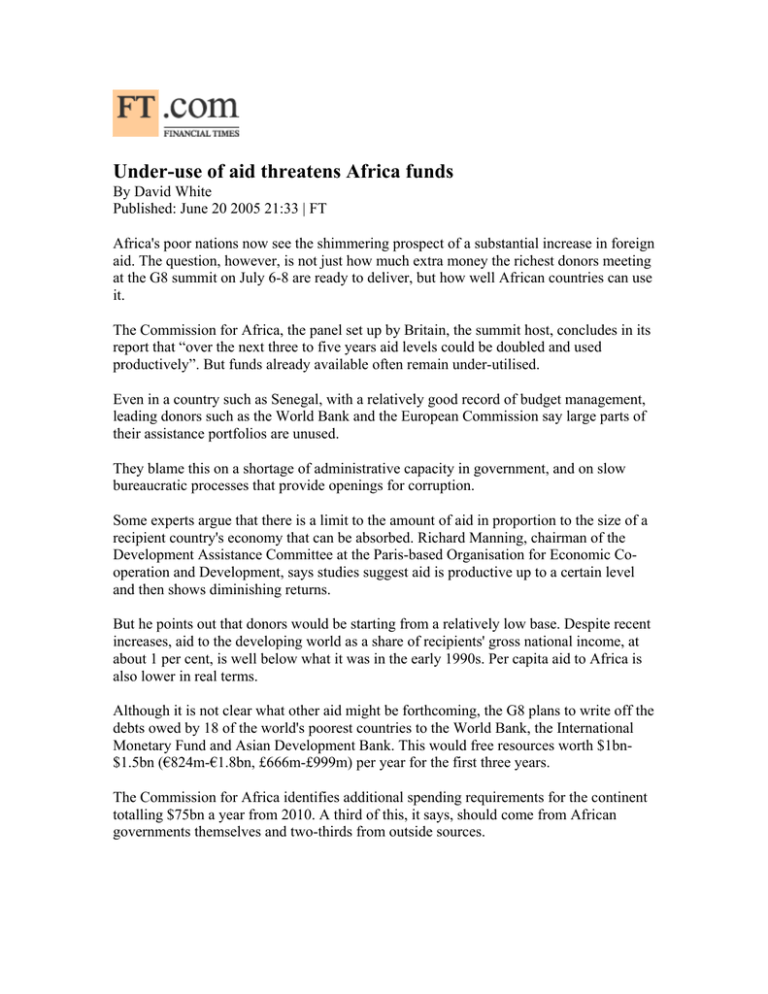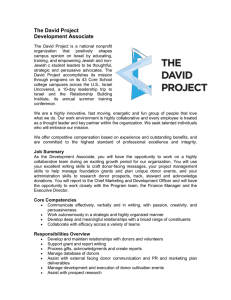Under-use of aid threatens Africa funds
advertisement

Under-use of aid threatens Africa funds By David White Published: June 20 2005 21:33 | FT Africa's poor nations now see the shimmering prospect of a substantial increase in foreign aid. The question, however, is not just how much extra money the richest donors meeting at the G8 summit on July 6-8 are ready to deliver, but how well African countries can use it. The Commission for Africa, the panel set up by Britain, the summit host, concludes in its report that “over the next three to five years aid levels could be doubled and used productively”. But funds already available often remain under-utilised. Even in a country such as Senegal, with a relatively good record of budget management, leading donors such as the World Bank and the European Commission say large parts of their assistance portfolios are unused. They blame this on a shortage of administrative capacity in government, and on slow bureaucratic processes that provide openings for corruption. Some experts argue that there is a limit to the amount of aid in proportion to the size of a recipient country's economy that can be absorbed. Richard Manning, chairman of the Development Assistance Committee at the Paris-based Organisation for Economic Cooperation and Development, says studies suggest aid is productive up to a certain level and then shows diminishing returns. But he points out that donors would be starting from a relatively low base. Despite recent increases, aid to the developing world as a share of recipients' gross national income, at about 1 per cent, is well below what it was in the early 1990s. Per capita aid to Africa is also lower in real terms. Although it is not clear what other aid might be forthcoming, the G8 plans to write off the debts owed by 18 of the world's poorest countries to the World Bank, the International Monetary Fund and Asian Development Bank. This would free resources worth $1bn$1.5bn (€824m-€1.8bn, £666m-£999m) per year for the first three years. The Commission for Africa identifies additional spending requirements for the continent totalling $75bn a year from 2010. A third of this, it says, should come from African governments themselves and two-thirds from outside sources. This implies almost a tripling of aid to Africa, which according to DAC figures reached $26bn in 2003. The extra annual bills include $20bn for infrastructure, $10bn to combat HIV/Aids, almost $20bn for other health spending and $7.5bn for education. But it notes that the figures were drawn up “taking no account of constraints of absorptive capacity”. Its recommendations aim at obtaining half the total in the next three to five years. Higher absorption rates should be possible as a result of “continuing policy and governance improvements”. It suggests that “results from current aid may be better than the past.” Steve Radelet, senior fellow at the Center for Global Development in Washington, says non-delivery of aid is partly the fault of donors as well as recipients. “Additional aid can be absorbed,” he says. “But we have to be much smarter about how we do it.” To avoid administrative bottlenecks, more aid needs to go outside direct government channels and be distributed through non-government organisations and private-sector entities, he says, citing as a model the approach adopted by the Global Fund to Fight Aids, Tuberculosis and Malaria. “You have to throw them the ball and let them run with it,” he says. The capacities of finance ministry bureaucracies are overstretched by the demands of meeting donor requirements, and sometimes undermined by donor programmes as staff are drained away to run aid projects. Governments, he argues, can become “more accountable to donors than to their own people”. He sees a clear tension between the desire to give recipient countries greater “ownership” of programmes and the capacity and institutional constraints in those countries. Aid needs to be combined with a strengthening of government systems, he says. At the same time, donors need to be more open about their activities, and about the share of aid going to consultants and other professionals close to donor governments. “It's actually shocking how untransparent the donors are,” he says. Trevor Manuel, South Africa's finance minister, suggested earlier this month that rich countries, following the example of the UK-backed Extractive Industries Transparency Initiative, should sign up to a “donor aid transparency initiative”. To improve absorption of aid, development agencies and governments especially European donors such as the UK, the Netherlands, Sweden and Denmark have been switching to broad support of sectoral and national budgets. ■ France will double its contribution to the global fund to combat Aids to €300m ($364m, £200m) and extend funding of micro-finance projects in Africa as part of the rich world's efforts to alleviate poverty, John Thornhill reports from Paris. At the G8 summit, France and Germany will also flesh out plans for an international tax on airline tickets to help fund Africa's economic development. Jacques Chirac, France's president, said yesterday that it was vital to introduce additional non-state financing mechanisms to provide regular funding for development. To this end, Mr Chirac will also unveil an action plan, drawn up with the Basle committee, to spread international best practice on micro-finance programmes. John Kay on G8,






